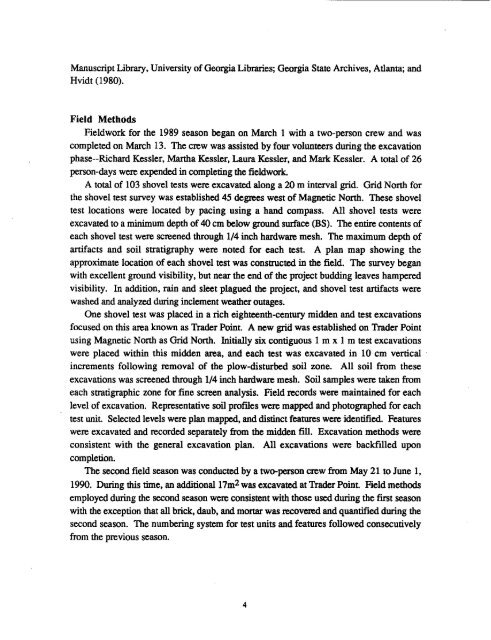Ye Pleasant Mount: 1989 1990 Excavations - Open site which ...
Ye Pleasant Mount: 1989 1990 Excavations - Open site which ...
Ye Pleasant Mount: 1989 1990 Excavations - Open site which ...
You also want an ePaper? Increase the reach of your titles
YUMPU automatically turns print PDFs into web optimized ePapers that Google loves.
Manuscript Library, University of Georgia Libraries; Georgia State Archives, Atlanta; and<br />
Hvidt (1980).<br />
Field MethOds<br />
Fieldwork for the <strong>1989</strong> season began on March 1 with a two-person crew and was<br />
completed on March 13. The crew was assisted by four volunteers during the excavation<br />
phase--Richard Kessler, Martha Kessler, Laura Kessler, and Mark Kessler. A total of 26<br />
person-days were expended in completing the fieldwork.<br />
A total of 103 shovel tests were excavated along a 20 m interval grid. Grid North for<br />
the shovel test survey was established 45 degrees west of Magnetic North. These shovel<br />
test locations were located by pacing using a hand compass. All shovel tests were<br />
excavated to a minimum depth of40 cm below ground surface (BS). The entire contents of<br />
each shovel test were screened through 1/4 inch hardware mesh. The maximum depth of<br />
artifacts and soil stratigraphy were noted for each test. A plan map showing the<br />
approximate location of each shovel test was constructed in the field. The survey began<br />
with excellent ground visibility, but near the end of the project budding leaves hampered<br />
visibility. In addition, rain and sleet plagued the project, and shovel test artifacts were<br />
washed and analyzed during inclement weather outages.<br />
One shovel test was placed in a rich eighteenth-century midden and test excavations<br />
focused on this area known as Trader Point. A new grid was established on Trader Point<br />
using Magnetic North as Grid North. Initially six contiguous 1 m xl m test excavations<br />
were placed within this midden area, and each test was excavated in 10 cm vertical<br />
increments following removal of the plow-disturbed soil zone. All soil from these<br />
excavations was screened through 1/4 inch hardware mesh. Soil samples were taken from<br />
each stratigraphic zone for fme screen analysis. Field records were maintained for each<br />
level of excavation. Representative soil profl1es were mapped and photographed for each<br />
test unit. Selected levels were plan mapped, and distinct features were identified. Features<br />
were excavated and recorded separately from the midden fill. Excavation methods were<br />
consistent with the general excavation plan. All excavations were backfilled upon<br />
completion.<br />
The second field season was conducted by a two-person crew from May 21 to June I,<br />
<strong>1990</strong>. During this time, an additional 17m2 was excavated at Trader Point. Field methods<br />
employed during the second season were consistent with those used during the first season<br />
with the exception that all brick, daub, and mortar was recovered and quantified during the<br />
second season. The numbering system for test units and features followed consecutively<br />
from the previous season.<br />
4










